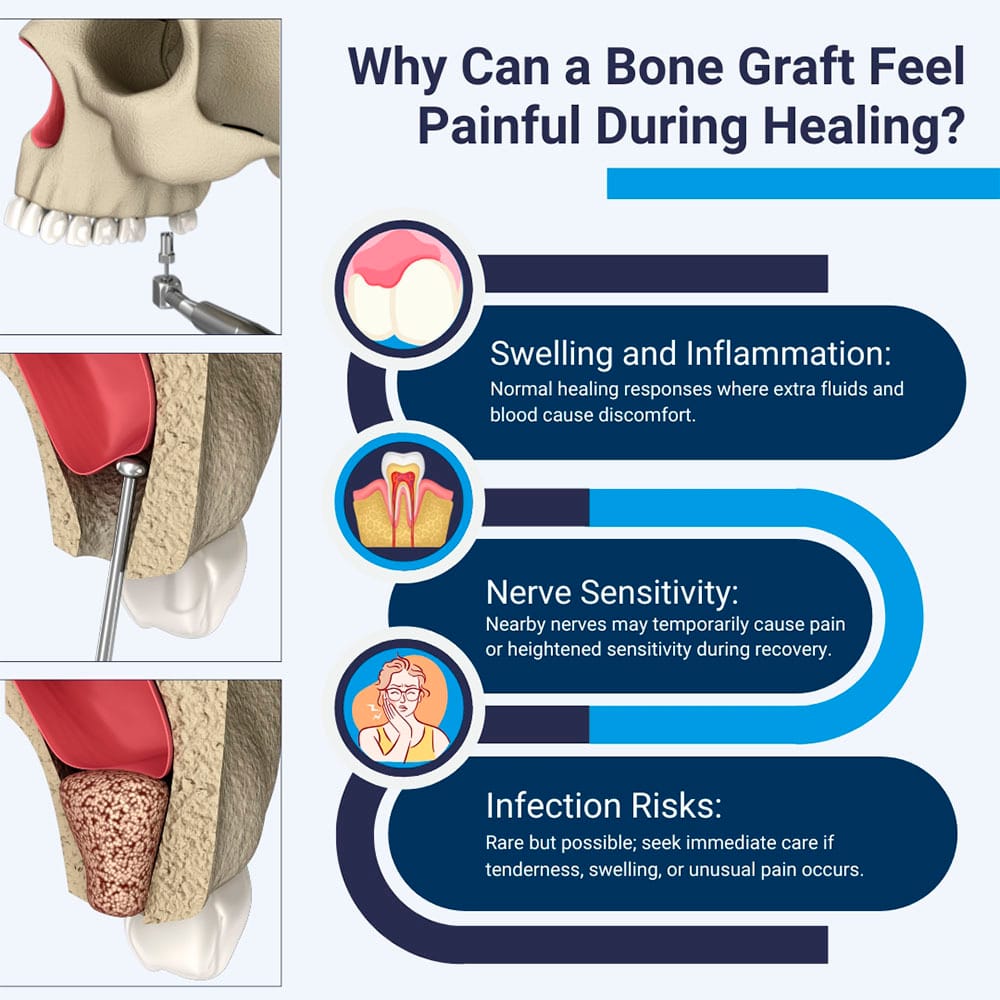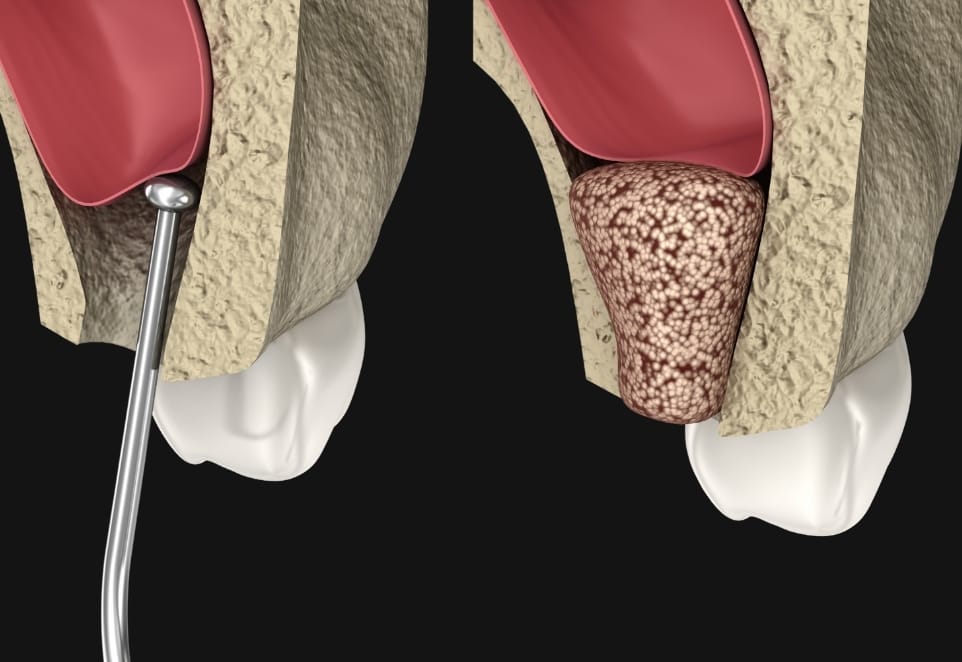This guide looks at what happens during the healing process and what can cause discomfort or pain. We also look at ways to manage any discomfort you may experience.
What Is a Bone Graft?
When you see an implant dentist, one of the first things they will need to do is assess your jawbone. They must evaluate the quantity and quality of bone available for implant insertion. Dental implants need to be surrounded by healthy, strong bone, giving them a good foundation with which to integrate and fuse.
Without enough bone, there is a real risk that your dental implants will not become fused firmly in your jawbone and may not be strong enough to support an implant restoration.
A dental bone graft is a way of restoring missing bone in areas where it is deficient. During this procedure, your dentist will use a bone grafting material that is inserted into the appropriate location, secured in place, and left to heal.
What is a Bone Graft Made from?
Various bone grafting materials are available. You may have bone taken from another site in your body, which ensures it will integrate extremely well with your jawbone. Alternatively, you can have donor bone that may be bovine or human. Donor bone is extremely well processed and tested extensively to ensure it is entirely safe for use. Frequently, a bone graft is made from synthetic materials.
A bone graft provides a scaffold or matrix, enabling new bone growth. Some bone grafts contain growth factors to encourage your body to produce new bone cells. Eventually, your bone replaces the bone graft.
Read more: Tips for Eating with New Dentures
What Happens After a Bone Graft Is Placed?
After a dental bone graft is placed, your body begins to heal. Below is what exactly happens.
Protective Blood Clot
After the bone graft is inserted, a protective blood clot will form around the surgery site. It helps form a barrier and is the first stage in healing.
New Blood Vessels
After the first few days, new blood vessels start to form in the bone graft. These begin transporting oxygen and other nutrients to the graft, enabling new bone cells to grow and develop around it.
New Bone Cells
Those new bone cells start developing after a week. As they grow and develop, they gradually replace the bone grafting material during a process called osteogenesis.
Read more: The 8 Best Alternatives to Invisalign
Bone Graft Integration
Your new bone graft should be well on the way to integrating with your jawbone 2 to 4 weeks after your bone grafting procedure. At this point, any discomfort or pain should start to fade.
Why Can a Bone Graft Feel Painful During Healing?
There are several reasons why you may experience pain or discomfort after a bone graft, even two weeks after the procedure.
Swelling and Inflammation
Swelling is your body’s response to any surgical procedure and is perfectly normal. It occurs because your body sends extra fluids and blood to the surgery site, which can cause swelling. An inflammatory response is also perfectly normal and is a natural part of the healing process.
Nerve Sensitivity
Your jawbone has nerves that may be near the bone grafting site. These nerves could be temporarily affected, causing increased sensitivity, discomfort, or pain. As your bone graft heals, any nerve sensitivity should decrease.

Read more: Do You Need a Root Canal? Seven Telltale Symptoms
Infection
Dental procedures like bone grafts are carried out following the strictest infection control procedures, so the risk of infection is rare. However, if an infection develops, it can cause tenderness, swelling, and pain.
Contact your dental implant dentist immediately if you suspect the bone grafting site might be infected. It’s essential to seek help urgently so your implant dentist can get rid of the infection and hopefully save the bone graft.
What to Do If You Feel Pain and Discomfort
Before your bone grafting procedure, your dental implant dentist will discuss what to expect during and afterward. They will ensure you know what’s normal to expect and how to cope. Below are some more tips to follow.
Follow Your Dental Implant Dentist’s Instructions Carefully
You will receive detailed instructions on how to care for your mouth during healing. It’s important to follow these instructions as closely as possible. They are designed to help you heal quickly and comfortably and reduce pain and discomfort.
Take Pain Relief Medications and Antibiotics
Take any prescribed antibiotics and pain relief medications as directed. It’s especially important to complete any course of antibiotics to avoid the risk of infection. If your implant dentist has prescribed pain medication, then don’t be afraid to take it, ensuring you don’t exceed the recommended dosage. While some discomfort is normal, you shouldn’t have to feel any significant pain during healing.
Use Cold Compresses and Moist Heat
During the first 24 hours after your dental implant bone graft, apply cold compresses to the outside of your mouth for 20 minutes on and 20 minutes off. These will help reduce swelling and discomfort. After this time, you can switch to moist heat and follow the same procedure to help you feel more comfortable.
Keep Your Mouth Clean
Although you may not be able to brush and floss your teeth properly initially, follow your implant dentist’s instructions on how to keep your mouth clean. They may prescribe an antimicrobial mouthwash for use during this time. They will also instruct you on when it’s safe to begin brushing and flossing any remaining teeth properly.
Keeping your mouth clean and hygienic will help prevent infection and promote faster healing.
Watch Your Diet
After a bone graft, you may need to change your diet initially while the bone graft heals. Your dental implant dentist can advise you on which foods are safe to eat. For the first few days, you may be advised to stick to a soft food diet such as yogurt, Mac and cheese, soups, mashed potatoes, and other softer foods like smoothies. Try to choose nutritious foods, as your body needs plenty of vitamins and nutrients to heal.
Get Plenty of Rest
Give yourself plenty of time to get over your oral surgery and avoid strenuous exercise or other activities that could interfere with healing. Your implant dentist can discuss when returning to normal everyday activities is okay.
Read more: 5 Tips for a Fast and easy Post-Gum Graft Recovery
When to Get Professional Dental Help
Finding a dental bone graft still feels uncomfortable after a couple of weeks is not unusual, but it’s important to know when to seek professional help. Contact your implant dentist immediately if you experience any of the following symptoms.
- Bleeding from the surgery site that fails to stop.
- Increased redness or swelling around the bone graft.
- Discharge or a buildup of pus around the bone graft.
- Fever or severe facial swelling.
- Severe pain that cannot be controlled with any prescribed medication.
If you are ever unsure whether you need professional dental help, always contact your dental office. They can advise you if what you are feeling is normal or if you need an emergency dental care appointment.
Complications after a dental bone graft are rare, and most people will heal with minimal side effects and discomfort.

